High-Gain Vivaldi Antenna with Wide Bandwidth Characteristics for 5G Mobile and Ku-Band Radar Applications
Abstract
:1. Introduction
2. Design and Optimization
2.1. Optimization of the Single Element AVA Design
2.2. Optimization of the Multi-Element AVA Design
3. Analysis and Results Discussion of the Proposed 8-Elements AVA
- Ku-Band (14.44–20.98 GHz)
- 1st mmW band (24.34–29 GHz)
- 2nd mmW band (33–40 GHz)
4. Comparison with Existing Vivaldi Antennas
5. Conclusions
Author Contributions
Funding
Data Availability Statement
Acknowledgments
Conflicts of Interest
References
- Buttazzoni, G.; Babich, F.; Vatta, F.; Comisso, M. Geometrical Synthesis of Sparse Antenna Arrays Using Compressive Sensing for 5G IoT Applications. Sensors 2020, 20, 350. [Google Scholar] [CrossRef] [PubMed] [Green Version]
- Sa’don, S.N.H.; Jamaluddin, M.H.; Kamarudin, M.R.; Ahmad, F.; Yamada, Y.; Kamardin, K.; Idris, I.H. Analysis of Graphene Antenna Properties for 5G Applications. Sensors 2019, 19, 4835. [Google Scholar] [CrossRef] [Green Version]
- Ramos, A.; Varum, T.; Matos, J.N. Compact Multilayer Yagi-Uda Based Antenna for IoT/5G Sensors. Sensors 2018, 18, 2914. [Google Scholar] [CrossRef] [PubMed] [Green Version]
- Naqvi, A.H.; Lim, S. Review of Recent Phased Arrays for Millimeter-Wave Wireless Communication. Sensors 2018, 18, 3194. [Google Scholar] [CrossRef] [PubMed] [Green Version]
- Iffat Naqvi, S.; Hussain, N.; Iqbal, A.; Rahman, M.; Forsat, M.; Mirjavadi, S.S.; Amin, Y. Integrated LTE and Millimeter-Wave 5G MIMO Antenna System for 4G/5G Wireless Terminals. Sensors 2020, 20, 3926. [Google Scholar] [CrossRef] [PubMed]
- Song, C.; Pan, L.; Jiao, Y.; Jia, J. A High-Performance Transmitarray Antenna with Thin Metasurface for 5G Communication Based on PSO (Particle Swarm Optimization). Sensors 2020, 20, 4460. [Google Scholar] [CrossRef]
- Ali, I.; Jamaluddin, M.H.; Gaya, A.; Rahim, H.A. A Dielectric Resonator Antenna with Enhanced Gain and Bandwidth for 5G Applications. Sensors 2020, 20, 675. [Google Scholar] [CrossRef] [Green Version]
- Zhang, J.; Zhang, S.; Lin, X.; Fan, Y.; Pedersen, G.F. 3D Radiation Pattern Reconfigurable Phased Array for Transmission Angle Sensing in 5G Mobile Communication. Sensors 2018, 18, 4204. [Google Scholar] [CrossRef] [Green Version]
- Ojaroudi Parchin, N.; Alibakhshikenari, M.; Jahanbakhsh Basherlou, H.; Abd-Alhameed, R.A.; Rodriguez, J.; Limiti, E. MM-Wave Phased Array Quasi-Yagi Antenna for the Upcoming 5G Cellular Communications. Appl. Sci. 2019, 9, 978. [Google Scholar] [CrossRef] [Green Version]
- Ojaroudi Parchin, N.; Jahanbakhsh Basherlou, H.; Al-Yasir, Y.I.A.; Ullah, A.; Abd-Alhameed, R.A.; Noras, J.M. Multi-Band MIMO Antenna Design with User-Impact Investigation for 4G and 5G Mobile Terminals. Sensors 2019, 19, 456. [Google Scholar] [CrossRef] [Green Version]
- Ojaroudi Parchin, N.; Jahanbakhsh Basherlou, H.; Al-Yasir, Y.I.A.; Abdulkhaleq, A.M.; Patwary, M.; Abd-Alhameed, R.A. A New CPW-Fed Diversity Antenna for MIMO 5G Smartphones. Electronics 2020, 9, 261. [Google Scholar] [CrossRef] [Green Version]
- Ojaroudi Parchin, N.; Jahanbakhsh Basherlou, H.; Alibakhshikenari, M.; Ojaroudi Parchin, Y.; Al-Yasir, Y.I.A.; Abd-Alhameed, R.A.; Limiti, E. Mobile-Phone Antenna Array with Diamond-Ring Slot Elements for 5G Massive MIMO Systems. Electronics 2019, 8, 521. [Google Scholar] [CrossRef] [Green Version]
- Khalid, M.; Iffat Naqvi, S.; Hussain, N.; Rahman, M.; Fawad; Mirjavadi, S.S.; Khan, M.J.; Amin, Y. 4-Port MIMO Antenna with Defected Ground Structure for 5G Millimeter Wave Applications. Electronics 2020, 9, 71. [Google Scholar] [CrossRef] [Green Version]
- Choi, J.; Park, J.; Youn, Y.; Hwang, W.; Seong, H.; Whang, Y.N.; Hong, W. Frequency-Adjustable Planar Folded Slot Antenna Using Fully Integrated Multithrow Function for 5G Mobile Devices at Millimeter-Wave Spectrum. IEEE Trans. Microw. Theory Tech. 2020, 68, 1872–1881. [Google Scholar] [CrossRef]
- Shafi, M.; Molisch, A.F.; Smith, P.J.; Haustein, T.; Zhu, P.; de Silva, P.; Tufvesson, F.; Benjebbour, A.; Wunder, G. 5G: A Tutorial Overview of Standards, Trials, Challenges, Deployment and Practice. IEEE J. Sel. Areas Commun. 2017, 35, 1201–1221. [Google Scholar] [CrossRef]
- Rappaport, T.S.; MacCartney, G.R.; Samimi, M.K.; Sun, S. Wideband millimeter-wave propagation measurements and channel models for future wireless communication system design. IEEE Trans. Commun. 2015, 63, 3029–3056. [Google Scholar] [CrossRef]
- Mak, K.M.; Lai, L.W.; Luk, K.M. A 5G Wideband Patch Antenna with Antisymmetric L-shaped Probe Feeds. IEEE Trans. Antennas Propag. 2018, 66, 957–961. [Google Scholar] [CrossRef]
- Ullah, R.; Ullah, S.; Umar, S.M.; Ullah, R.; Kamal, B. Design and Modeling of a 28/38/60/70/80 GHz Antenna for Fifth Generation (5G) Mobile and Millimeter Wave (mmW) Applications. In Proceedings of the 2019 International Conference on Electrical, Communication, and Computer Engineering (ICECCE), Swat, Pakistan, 24–25 July 2019; pp. 1–7. [Google Scholar]
- Syrytsin, I.; Zhang, S.; Pedersen, G.F. Compact Quad-Mode Planar Phased Array with Wideband for 5G Mobile Terminals. IEEE Antennas Wirel. Propag. Lett. 2018, 66, 4648–4657. [Google Scholar] [CrossRef] [Green Version]
- Wei, L.; Hu, R.Q.; Qian, Y.; Wu, G. Key elements to enable millimeter wave communications for 5G wireless systems. IEEE Wirel. Commun. 2014, 21, 136–143. [Google Scholar]
- Nassar, I.T.; Weller, T.M. A novel method for improving antipodal Vivaldi antenna performance. IEEE Trans. Antennas Propag. 2015, 63, 3321–3324. [Google Scholar] [CrossRef]
- Xu, H.-X.; Wang, G.-M.; Tao, Z.; Cui, T.J. High-directivity emissions with flexible beam numbers and beam directions using gradientrefractive-index fractal metamaterial. Sci. Rep. 2014, 4, 5744. [Google Scholar] [CrossRef] [PubMed] [Green Version]
- Moosazadeh, M.; Kharkovsky, S. A compact high-gain and front-toback ratio elliptically tapered antipodal Vivaldi antenna with trapezoidshaped dielectric lens. IEEE Antennas Wirel. Propag. Lett. 2016, 15, 552–555. [Google Scholar] [CrossRef]
- Zhang, H.; Sun, H.; Yang, T.; Mahe, Y.; Razban, T. Design of A Wideband and Dual-Polarized CPW-Fed Monopole Antenna for Future 5G Communications. In Proceedings of the 2016 IEEE 84th Vehicular Technology Conference (VTC-Fall), Montreal, QC, Canada, 18–21 September 2016; pp. 1–5. [Google Scholar]
- Ying, Z.; Zhao, K.; Bolin, T.; He, S.; Scannavini, A.; Foged, L.J.; Nicolas, G. Multiplexing Efficiency of High Order MIMO in Mobile Terminal for 5G communication at 15GHz. In Proceedings of the 2016 International Symposium on Antennas and Propagation (ISAP), Okinawa, Japan, 24–28 October 2016; pp. 594–595. [Google Scholar]
- Xu, B.; Zhao, K.; Thors, B.; Colombi, D.; Lundberg, O.; Ying, Z.; He, S. Power Density Measurements at 15 GHz for RF EMF Compliance Assessments of 5G User Equipment. IEEE Trans. Antennas Propag. 2017, 65, 6584–6595. [Google Scholar] [CrossRef]
- Zhao, K.; Ying, Z.; He, S. Human Exposure to mmWave Phased Array Antennas in Mobile Terminal for 5G Mobile System. In Proceedings of the 2015 IEEE 81st Vehicular Technology Conference (VTC Spring), Glasgow, UK, 11–14 May 2015; pp. 1–2. [Google Scholar]
- Asbeck, P.M. Will Doherty Continue to Rule for 5G? In Proceedings of the 2016 IEEE MTT-S International Microwave Symposium (IMS), San Francisco, CA, USA, 22–27 May 2016; pp. 1–4. [Google Scholar]
- Tsutsumi, K.; Yamamoto, W.; Maruyama, T.; Fujiwara, T.; Somada, I.; Hagiwara, T.; Taniguchi, E. A 15GHz 4-Channel Transmit/Receive RF Core-Chip for High SHF Wide-band Massive MIMO in 5G. In Proceedings of the 2017 IEEE 17th Topical Meeting on Silicon Monolithic Integrated Circuits in RF systems (SiRF), Phoenix, AZ, USA, 15–18 January 2017; pp. 115–117. [Google Scholar]
- Scannavini, A.; Foged, L.J.; Giacomini, A.; Duchesne, L.; Gross, N.; Herbiniere, F. Efficient testing of antennas for 5G mm-wave applications. In Proceedings of the 12th European Conference on Antennas and Propagation (EuCAP 2018), London, UK, 9–13 April 2018; pp. 1–4. [Google Scholar]
- Noren, P.; Foged, L.J.; Scialacqua, L.; Scannavini, A. Measurement and Diagnostics of Millimeter Waves 5G Enabled Devices. In Proceedings of the 2018 IEEE Conference on Antenna Measurements & Applications (CAMA), Vasteras, Sweden, 3–6 September 2018; pp. 1–4. [Google Scholar]
- Abdalrazik, A.; Abdelrahman, A.B.; Allam, A.; Abo-Zahhad, M. A Wideband Dielectric Resonator Antenna with Truncated Ground for 5G Applications. In Proceedings of the 2018 48th European Microwave Conference (EuMC), Madrid, Spain, 23–27 September 2018; pp. 1085–1086. [Google Scholar]
- Yang, Y.; Sun, B.; Guo, J. A Single-Layer Wideband Circularly Polarized Antenna for Millimeter-Wave Applications. IEEE Trans. Antennas Propag. 2020, 68, 4925–4929. [Google Scholar] [CrossRef]
- Liu, P.; Zhu, X.; Zhang, Y.; Wang, X.; Yang, C.; Jiang, Z.H. Patch Antenna Loaded With Paired Shorting Pins and H-Shaped Slot for 28/38 GHz Dual-Band MIMO Applications. IEEE Access 2020, 8, 23705–23712. [Google Scholar] [CrossRef]
- Khan, Z.U.; Loh, T.H.; Belenguer, A.; Alomainy, A. Empty Substrate-Integrated Waveguide-Fed Patch Antenna Array for 5G Millimeter-Wave Communication Systems. IEEE Antennas Wirel. Propag. Lett. 2020, 19, 776–780. [Google Scholar] [CrossRef]
- Gudarzi, A.; Mahzoon, M.; Bazrkar, A.; Mohajeri, F. Gain enhancement and miniaturization of microstrip antennas using MTM superstrates. In Proceedings of the 2012 International Conference on Computer and Communication Engineering (ICCCE), Kuala Lumpur, Malaysia, 3–5 July 2012; pp. 859–863. [Google Scholar]
- Balanis, C.A. Antenna Theory: Analysis and Design, 3rd ed.; Wiley-Interscience: New York, NY, USA, 2005. [Google Scholar]
- Dixit, A.S.; Kumar, S. The enhanced gain and cost-effective antipodal Vivaldi antenna for 5G communication applications. Microw. Opt. Technol. Lett. 2020, 62, 2365–2374. [Google Scholar] [CrossRef]
- Masoodi, I.S.; Ishteyaq, I.; Muzaffar, K.; Magray, M.I. Low Cost Substrate Based Compact Antennas for 4G/5G Side-Edge Panel Smartphone Applications. Prog. Electromagn. Res. Lett. 2020, 91, 145–152. [Google Scholar] [CrossRef]
- Gorai, A.; Karmakar, A.; Pal, M.; Ghatak, R. A super wideband Chebyshev tapered antipodal Vivaldi antenna. AEU Int. Electron. Commun. 2015, 69, 1328–1333. [Google Scholar] [CrossRef]
- Goel, T.; Patnaik, A. Novel Broadband Antennas for Future Mobile Communications. IEEE Trans. Antennas Propag. 2018, 66, 2299–2308. [Google Scholar] [CrossRef]
- Yang, K.; Hoang, M.H.; Bao, X.; McEvoy, P.; Ammann, M.J. Dual-stub Ka-band Vivaldi antenna with integrated bandpass filter. IET Microw. Antennas Propag. 2018, 12, 668–671. [Google Scholar] [CrossRef] [Green Version]
- Bai, J.; Shi, S.; Prather, D.W. Modified compact antipodal Vivaldi antenna for 4-50-GHz UWB application. IEEE Trans. Microw. Theory Tech. 2011, 59, 1051–1057. [Google Scholar] [CrossRef]
- Lee, W.; Hwang, I.; Jang, B. End-Fire Vivaldi Antenna Array With Wide Fan-Beam for 5G Mobile Handsets. IEEE Access 2020, 8, 118299–118304. [Google Scholar] [CrossRef]
- Si, L.-M.; Tang, H.-B.; Shui, X.; Lu, H.-D.; Liu, Y.; Ge, Y.-F.; Lv, X. Design of a 6–18 GHz UWB conformal antipodal Vivaldi antenna array. In Proceedings of the 2013 IEEE International Conference on Microwave Technology & Computational Electromagnetics, Qingdao, China, 25–28 August 2013; pp. 153–156. [Google Scholar] [CrossRef]
- Dixit, A.S.; Kumar, S. A Miniaturized Antipodal Vivaldi Antenna for 5G Communication Applications. In Proceedings of the 2020 7th International Conference on Signal Processing and Integrated Networks (SPIN), Noida, India, 27–28 February 2020; pp. 800–803. [Google Scholar]
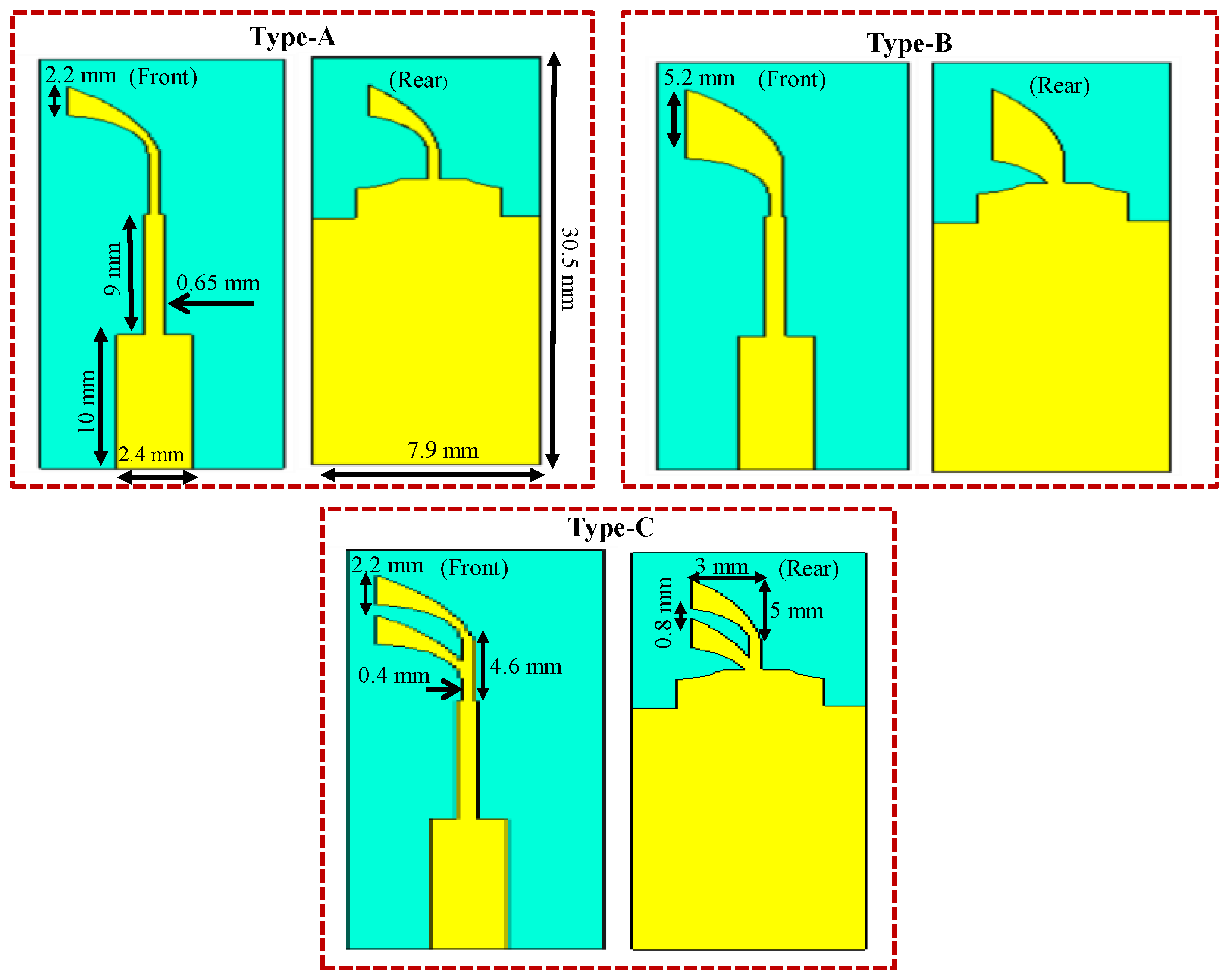
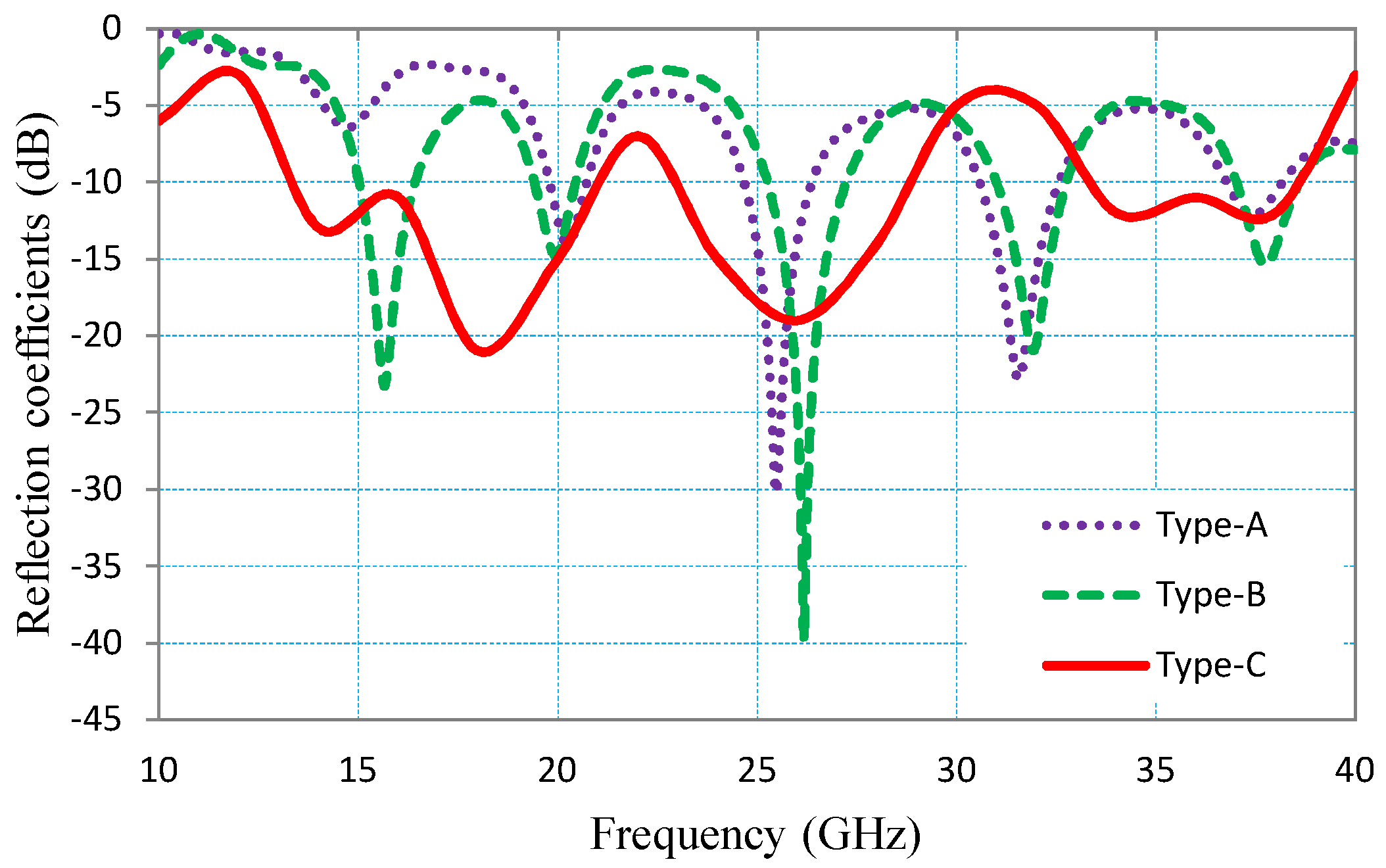
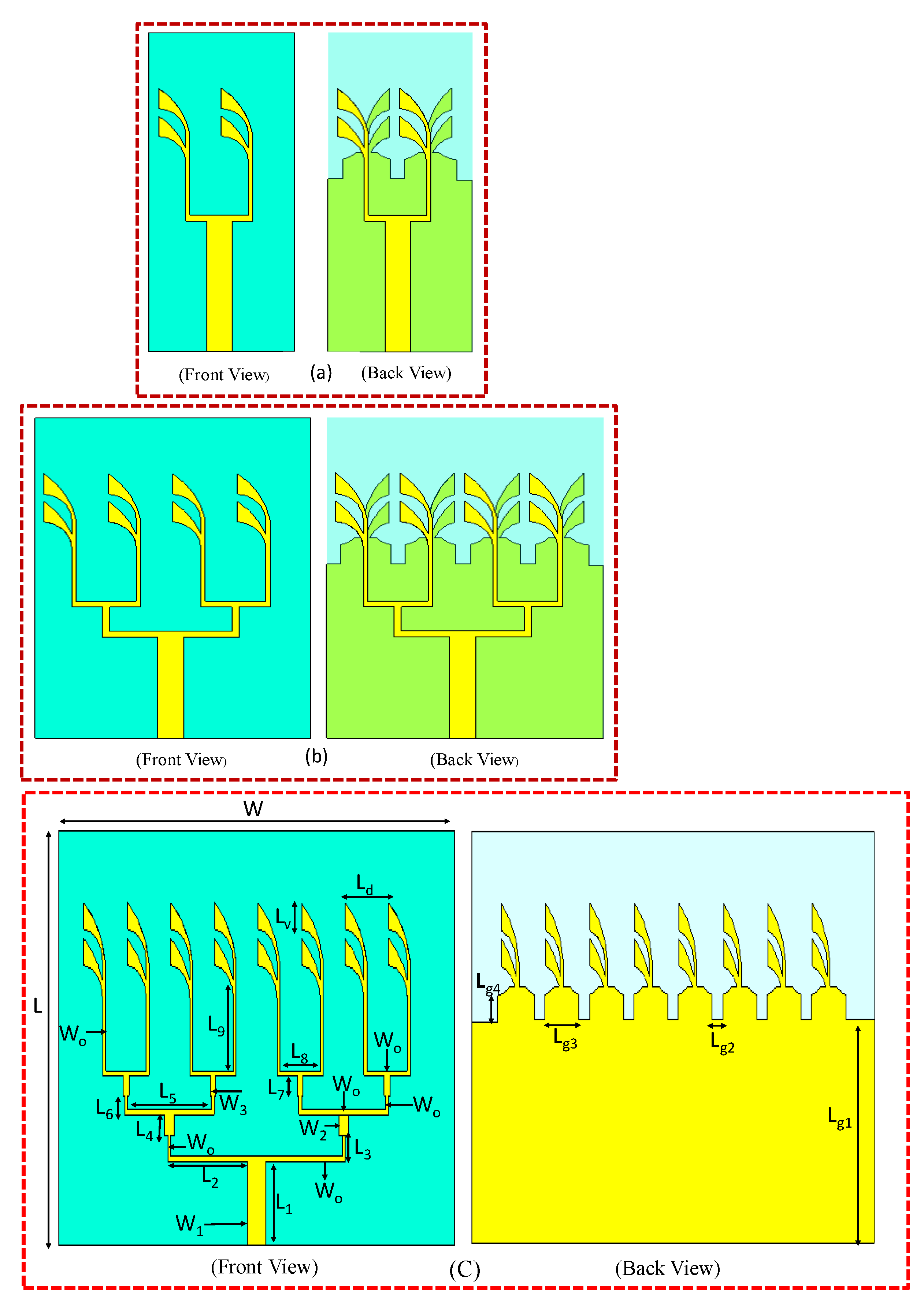

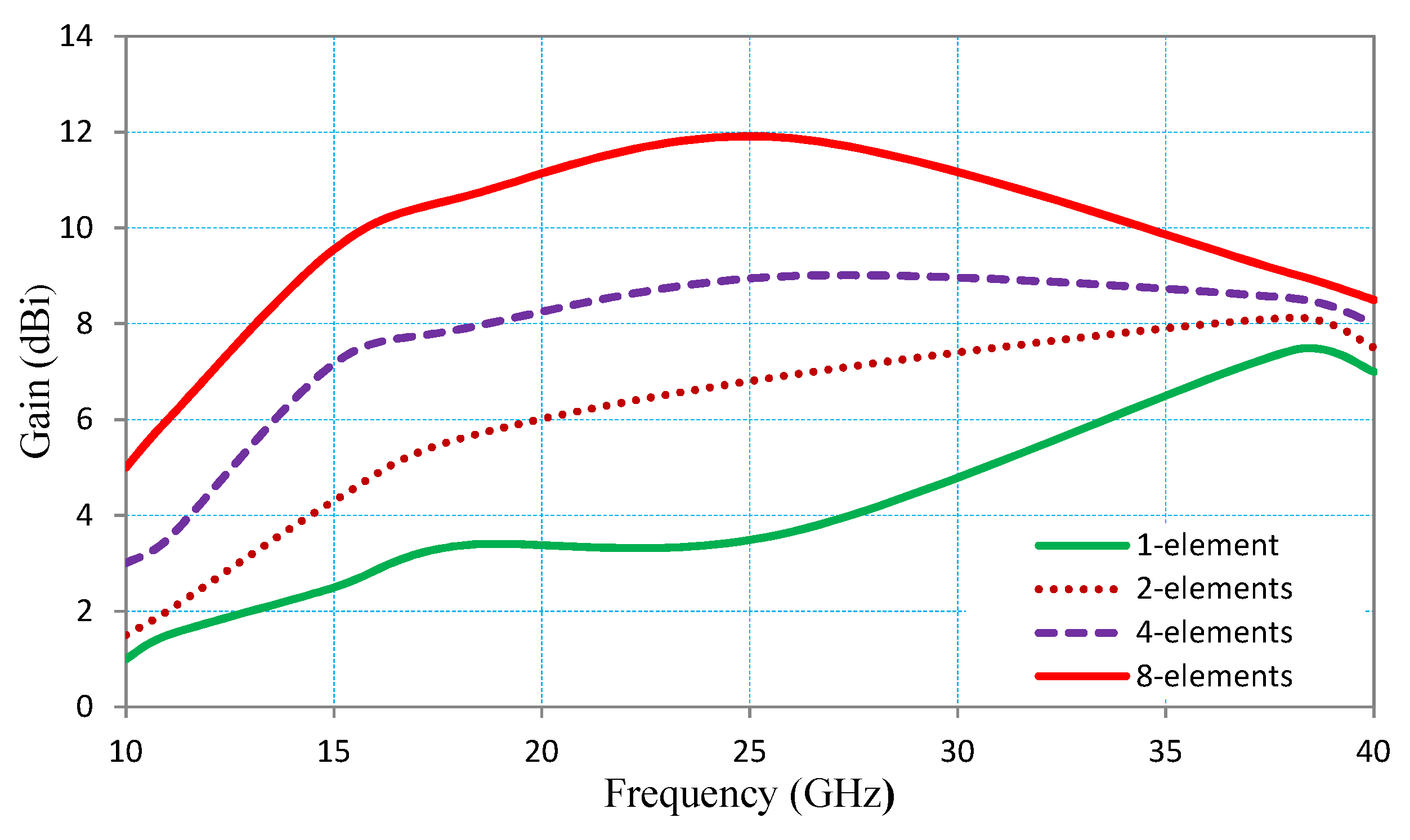
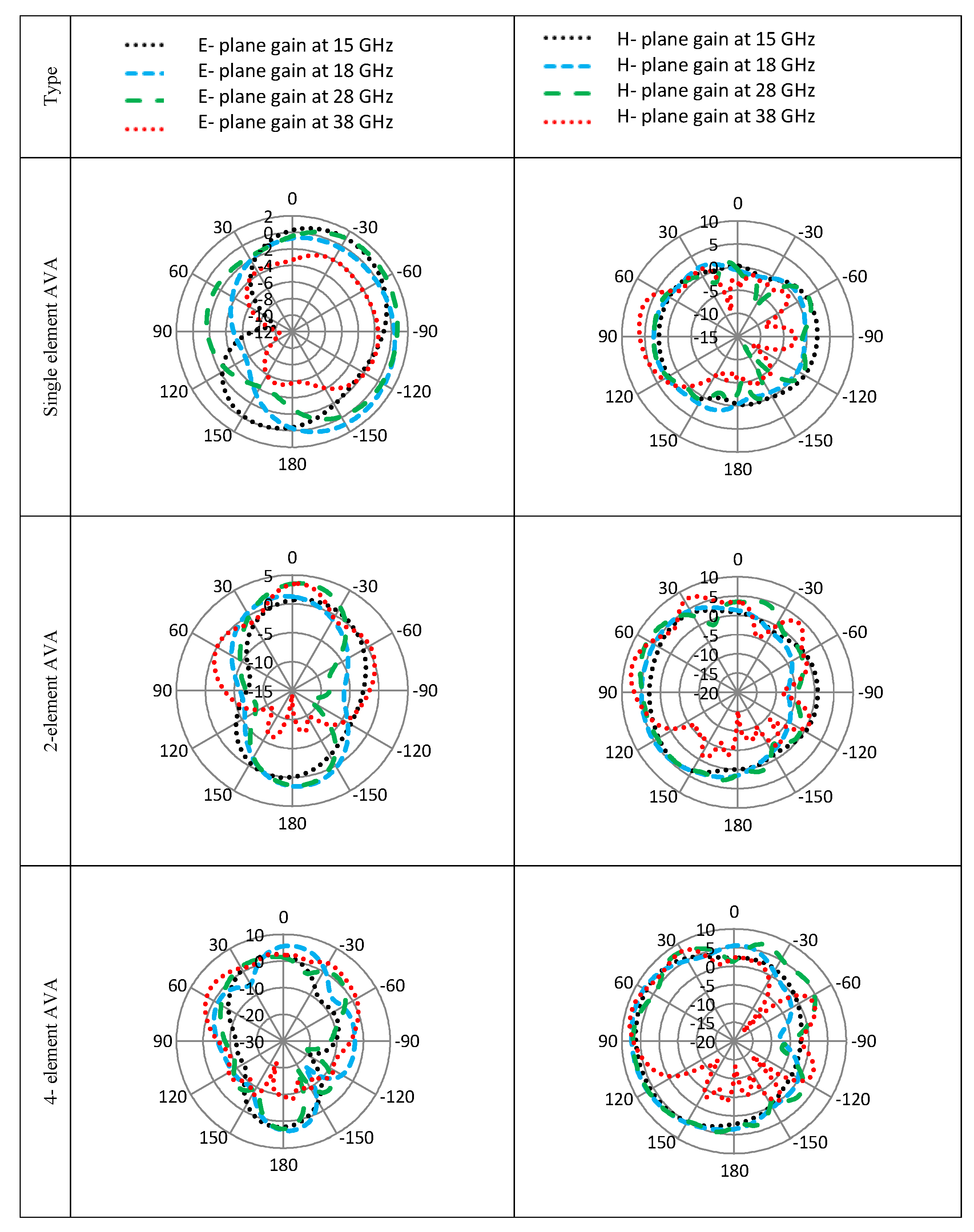
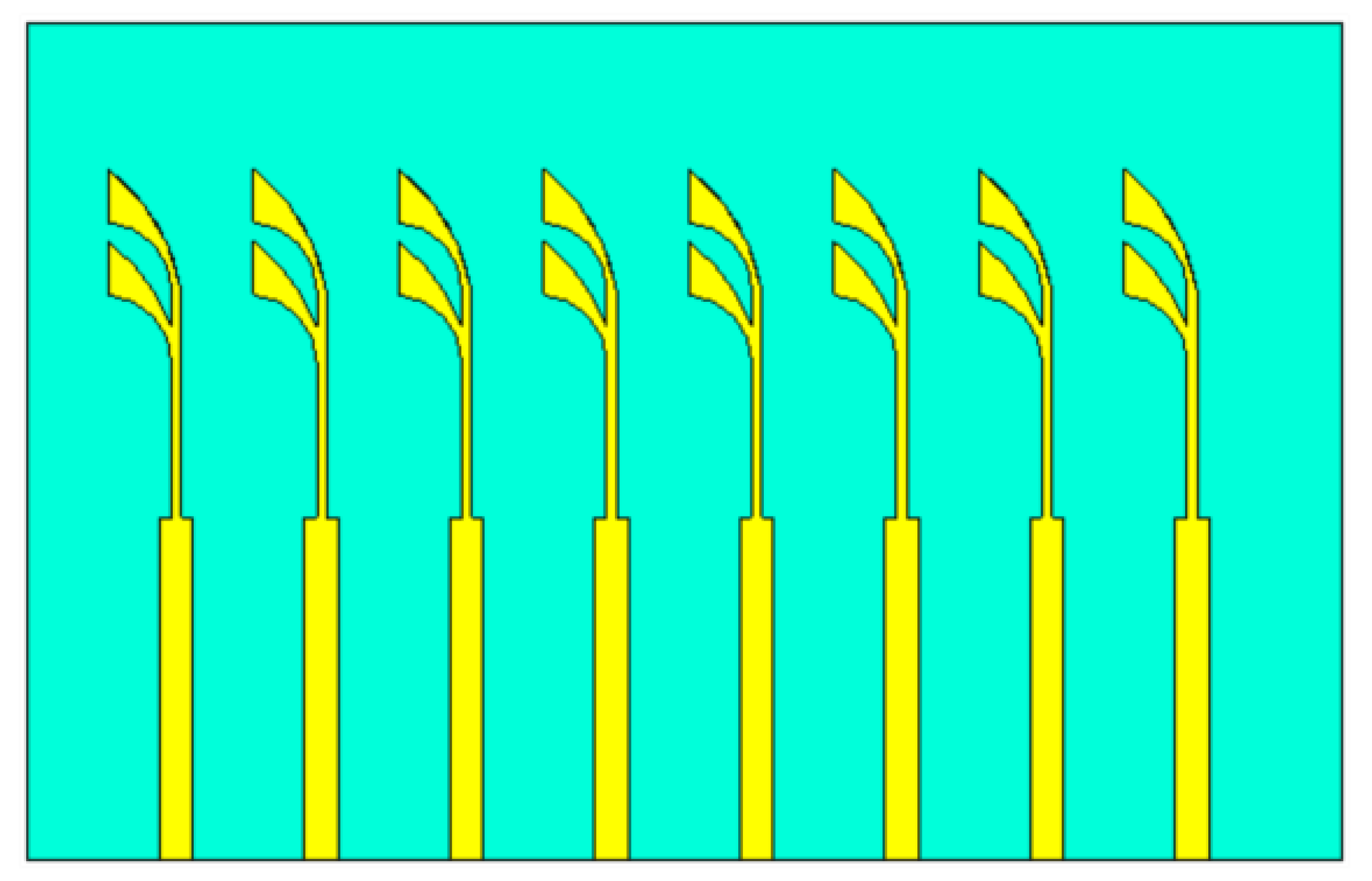
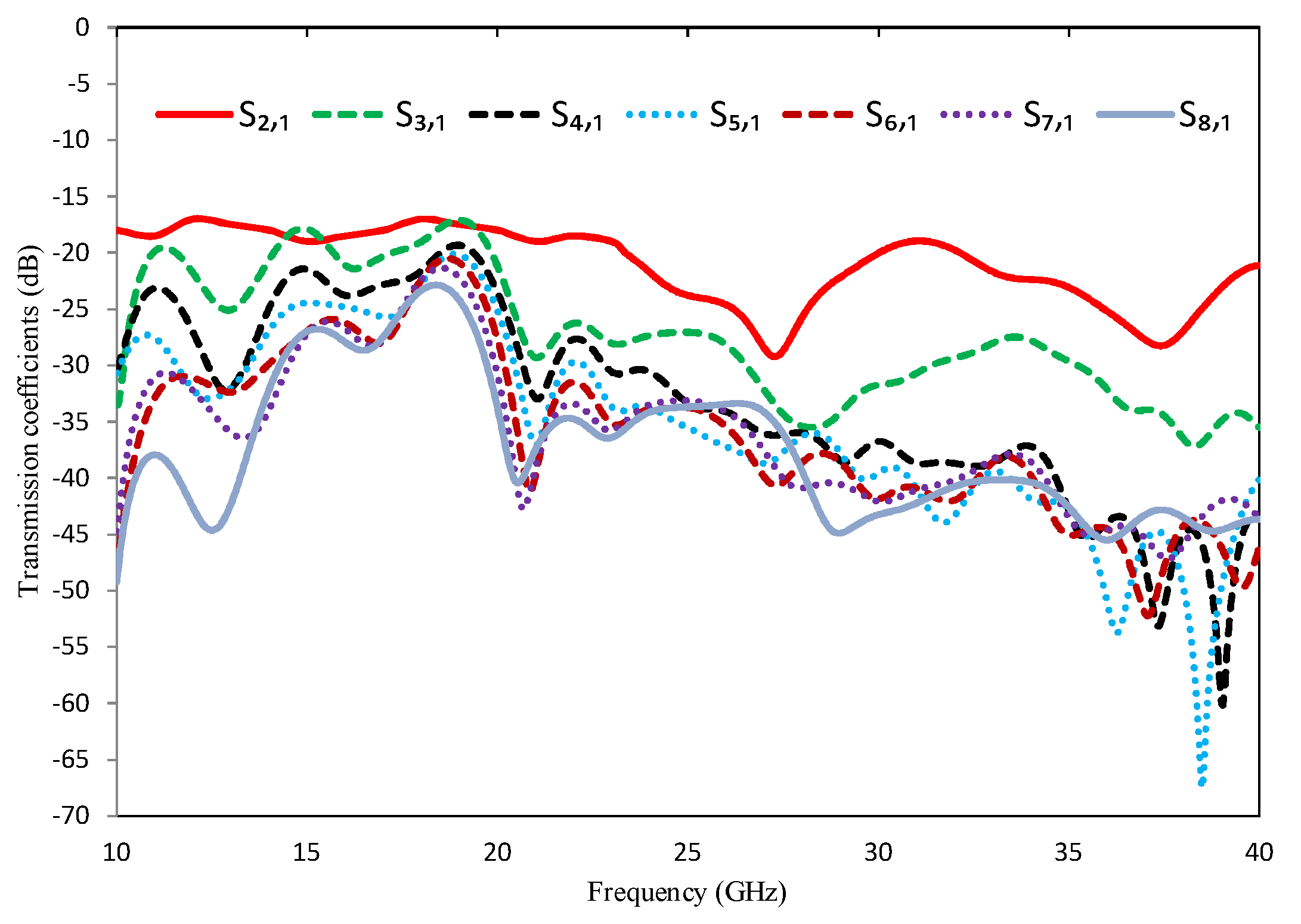

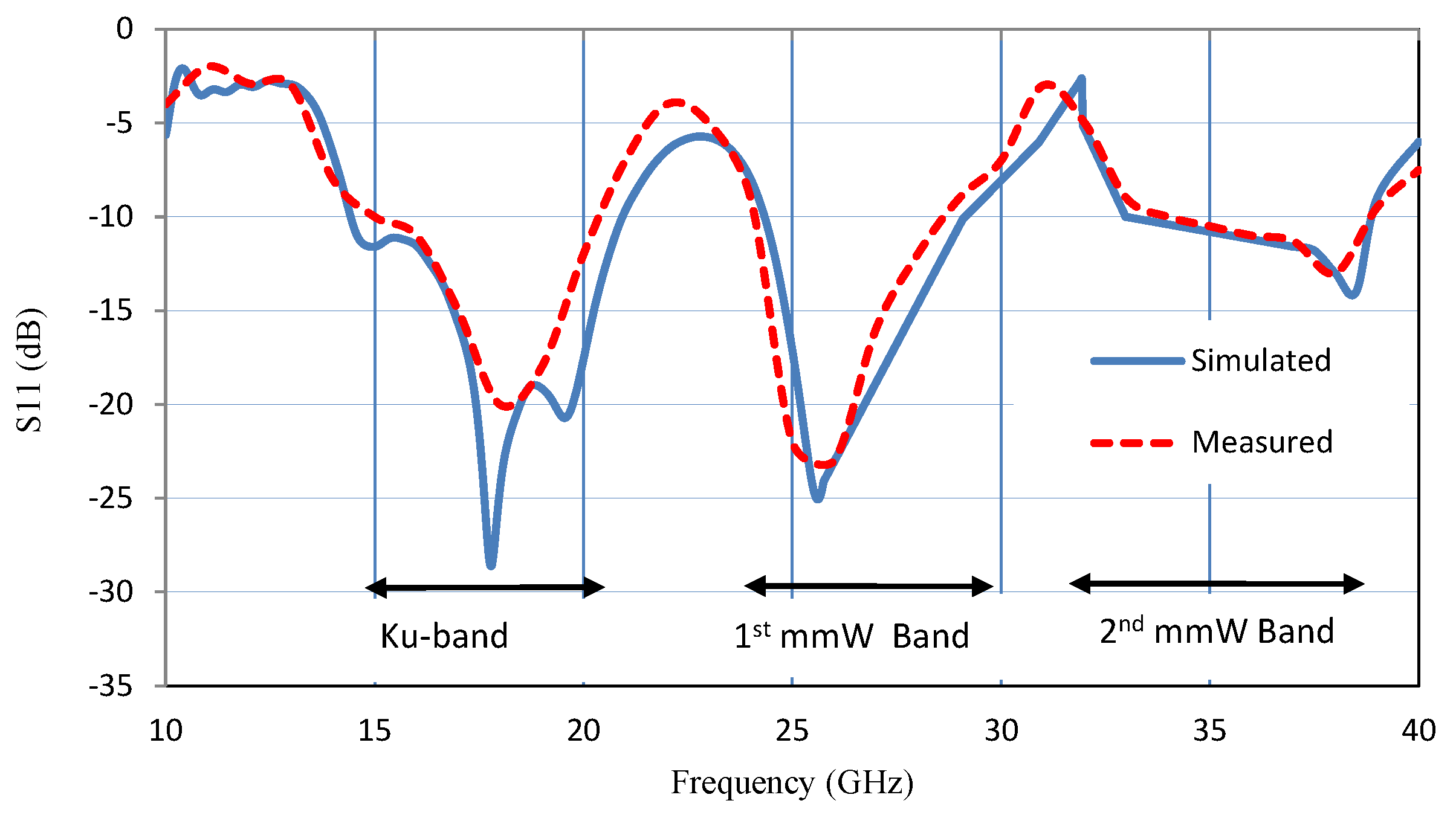

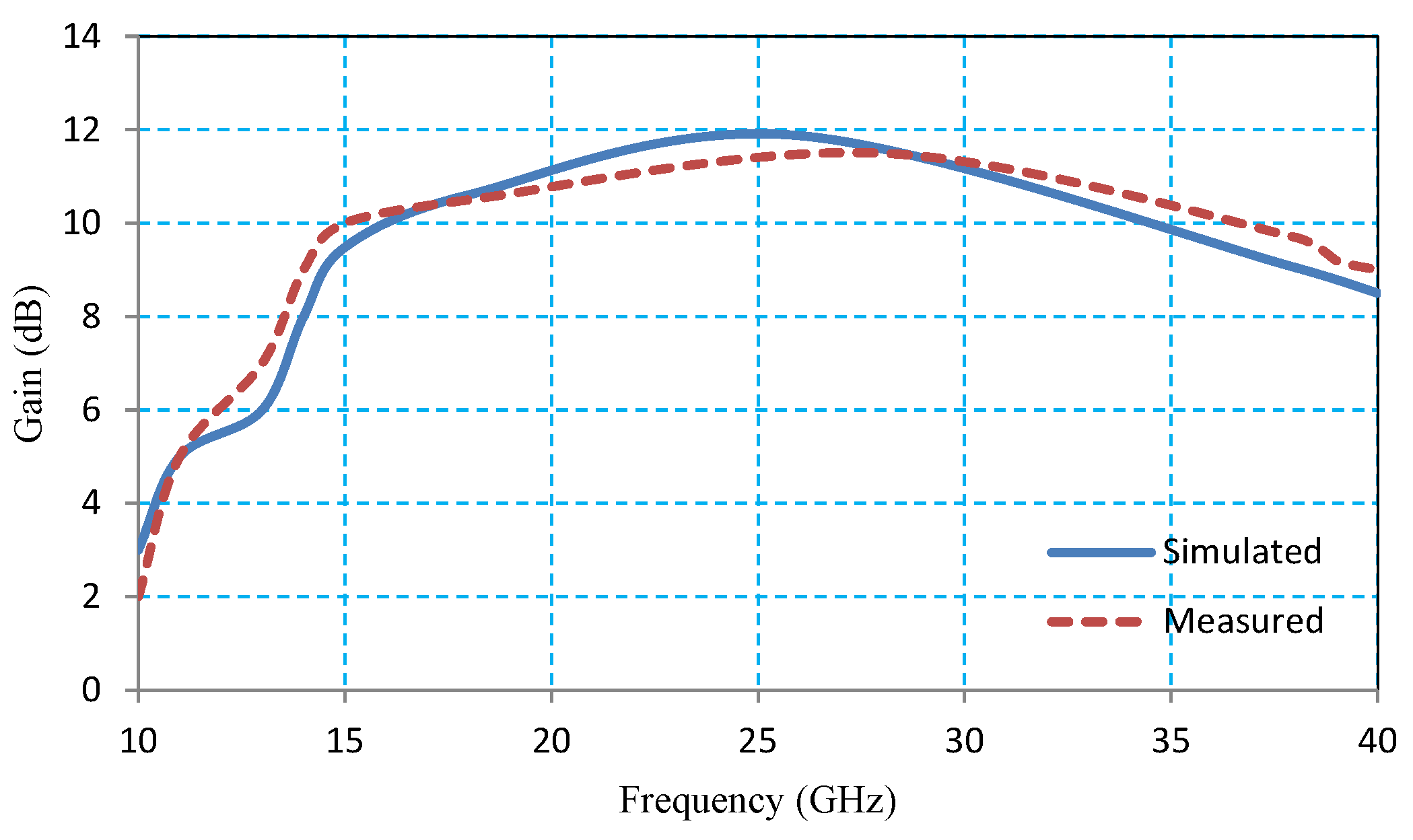
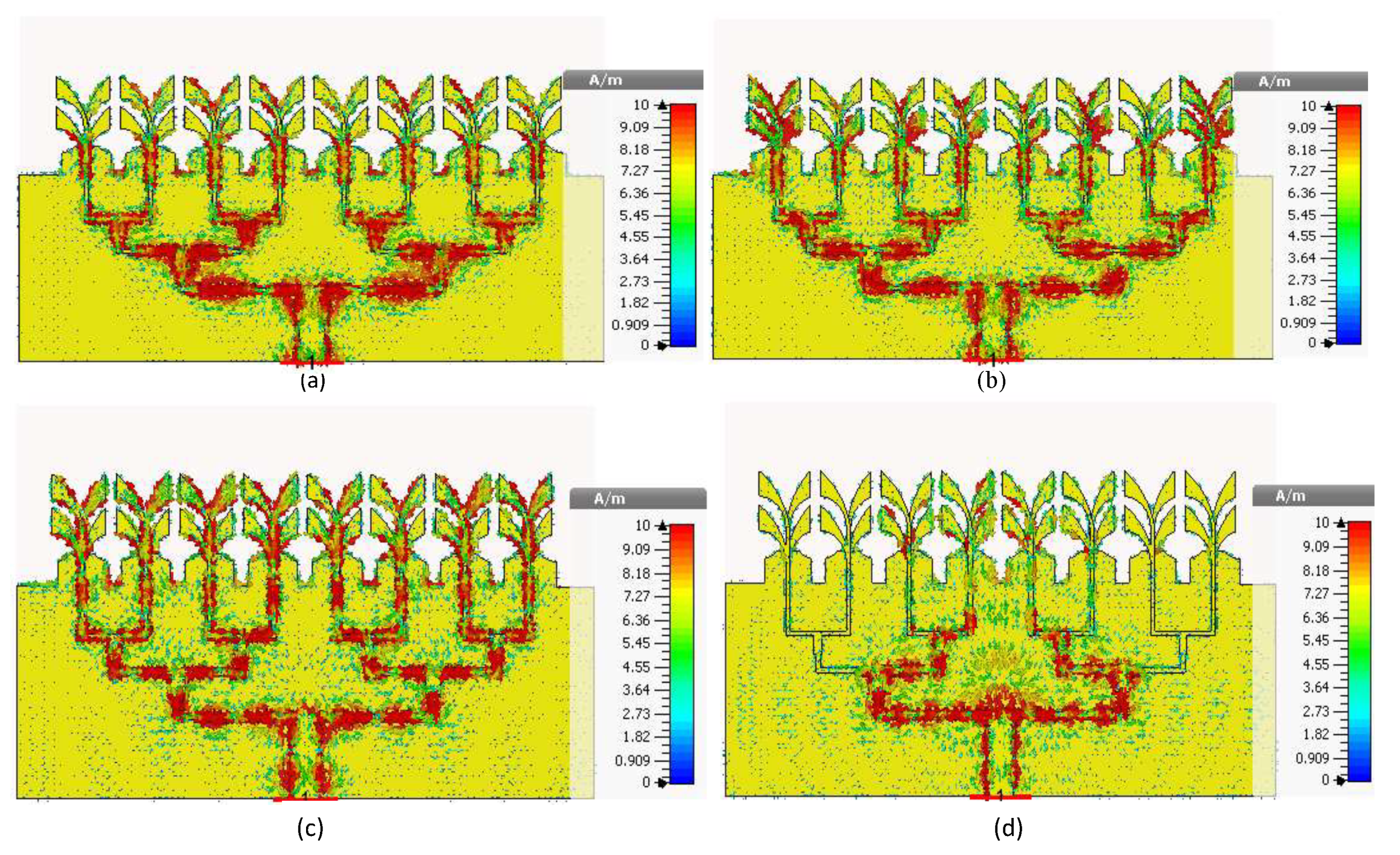

| Parameter | L | L1 | L2 | L3 | L4 | L5 | L6 |
| Value (mm) | 33.31 | 7 | 12 | 2.2 | 1.69 | 12.4 | 1.6 |
| Parameter | L | L | L | L | L | L | L |
| Value (mm) | 1.653 | 6.4 | 6.405 | 2.2 | 6 | 18.748 | 1.4 |
| Parameter | L | L | W | W | W | W | W |
| Value (mm) | 5 | 2.252 | 54.96 | 2.43 | 0.4 | 1.371 | 0.811 |
| (a) 1– Element | (c) 4– Element | ||||||||||
|---|---|---|---|---|---|---|---|---|---|---|---|
| f (GHz) | Plane | MLM | MLD | HPBW | SLL | f (GHz) | Plane | MLM | MLD | HPBW | SLL |
| (dB) | (deg) | (deg) | (dB) | (dB) | (deg) | (deg) | (dB) | ||||
| 15 | E | 1.02 | –31 | 137.3 | –1.1 | E | 2.79 | 10 | 48.2 | –11.1 | |
| H | 2.33 | –73 | 153.7 | –2.1 | 15 | H | 7.17 | 55 | 138.4 | –4.7 | |
| 18 | E | 1.02 | –139 | 228.6 | 0 | E | 5.81 | –6 | 36.9 | –2.1 | |
| H | 3.11 | 94 | 169.7 | –2.1 | 18 | H | 7.89 | 67 | 125.5 | –2.3 | |
| 28 | E | 1.19 | –45 | 266 | 0 | E | 2.92 | 180 | 24.9 | –1.5 | |
| H | 3.2 | 103 | 120 | –2 | 28 | H | 7.86 | 35 | 41.7 | –2.6 | |
| 38 | E | –1.53 | –99 | 201.2 | 0 | E | 3.77 | –33 | 85.9 | –0.9 | |
| H | 6.54 | 76 | 61.2 | –5 | 38 | H | 7.86 | 35 | 41.7 | –2.6 | |
| (b) 2– Element | (d) 8–Element | ||||||||||
| f (GHz) | Plane | MLM | MLD | HPBW | SLL | f (GHz) | Plane | MLM | MLD | HPBW | SLL |
| (dB) | (deg) | (deg) | (dB) | (dB) | (deg) | (deg) | (dB) | ||||
| 15 | E | 1 | –17 | 109.1 | 0 | E | 5.4 | 4 | 22 | –7.1 | |
| H | 4.2 | 40 | 156.9 | 0 | 15 | H | 9.56 | 46 | 155.5 | –4.2 | |
| 18 | E | 1.62 | –174 | 72.6 | 0 | E | 8.24 | 0 | 18.2 | –1.8 | |
| H | 5.1 | 4 | 7 164.3 | 0 | 18 | H | 10.6 | 58 | 130 | –2.2 | |
| 28 | E | 3.66 | –7 | 60.3 | –2.2 | E | 5.75 | 1 | 13 | –2.6 | |
| H | 6.84 | 61 | 112.9 | –2.5 | 28 | H | 11.9 | –19 | 26.4 | –2.3 | |
| 38 | E | 3.55 | –4 | 40.6 | –3 | E | 5.11 | 75 | 26.4 | –1.7 | |
| H | 8.13 | 76 | 42.8 | –4.1 | 38 | H | 9.06 | 74 | 42.7 | –3.8 | |
| Comparison of Single Element Designs | |||||||
|---|---|---|---|---|---|---|---|
| Ref No. | Year | Size ( × × ) | Operating Frequency | BW | Efficiencies | Number | Measured |
| (Is Taken in mm) | (GHz) | (GHz) | (%) | of Elements | Gain (dBi) | ||
| [38] | 2020 | 6.93 × 4.15 × 0.27 | 24.8–34.52 | 9.72 | N.M | 01 | 7.27 |
| [39] | 2020 | 0.56 × 0.82 × 0.046 | 23–39 | 16 | N.M | 01 | 7.2 |
| [40] | 2015 | 0.7 × 0.7 × 0.011 | 1–35 | 34 | >77 | 01 | 6.8 |
| [41] | 2018 | 2.087 × 1.52 × 0.09 | 10–40 | 30 | N.M | 01 | 8.5 |
| [42] | 2018 | 4.51 × 2.136 × 0.033 | 27–31 | 04 | 84.9 | 01 | 8.51 |
| [43] | 2011 | 3.3 × 3.43 × 0.015 | 4–50 | 46 | N.M | 01 | 3–12 |
| 1.83 × 0.47 × 0.05 | 14.44–20.98 | 6.54 | 3.4 | ||||
| This | 24.34–29 | 4.66 | >86 | 01 | 3.6 | ||
| Work | 33–40 | 7 | 7.4 | ||||
| Comparison of Four Element Designs | |||||||
| Ref No. | Year | Size ( × × ) | Operating Frequency | BW | Efficiencies | Number | Measured |
| ( Is Taken in mm) | (GHz) | (GHz) | (%) | of Elements | Gain (dBi) | ||
| [44] | 2020 | 5.60 × 12.61 × 0.073 | 27.5–28.5 | 01 | 80 | 04 | 8.01 |
| [45] | 2013 | 2.02 × 1.52 × 1.52 | 6–18 | 6 | N.M | 04 | N.M |
| 2.69 × 2.24 × 0.023 | 24.91–33.18 | 8.27 | |||||
| [46] | 2020 | 34.95–36.58 | 1.63 | N.M | 04 | N.M | |
| 38.34–39.38 | 1.04 | ||||||
| 1.8 × 2.1 × 0.05 | 14.44–20.98 | 6.54 | 8.10 | ||||
| This | 24.34–29 | 4.66 | >86 | 04 | 8.32 | ||
| Work | 33–40 | 7 | 8.54 | ||||
| Proposed Eight Element Design | |||||||
| Ref No. | Year | Size ( × × ) | Operating Frequency | BW | Efficiencies | Number | Measured |
| ( Is Taken in mm) | (GHz) | (GHz) | (%) | of Elements | Gain (dBi) | ||
| 2 × 3.3 × 0.05 | 14.44–20.98 | 6.54 | |||||
| This | 24.34–29 | 4.66 | >86 | 08 | >10 | ||
| Work | 33–40 | 7 | |||||
Publisher’s Note: MDPI stays neutral with regard to jurisdictional claims in published maps and institutional affiliations. |
© 2021 by the authors. Licensee MDPI, Basel, Switzerland. This article is an open access article distributed under the terms and conditions of the Creative Commons Attribution (CC BY) license (http://creativecommons.org/licenses/by/4.0/).
Share and Cite
Ullah, R.; Ullah, S.; Faisal, F.; Ullah, R.; Choi, D.-y.; Ahmad, A.; Kamal, B. High-Gain Vivaldi Antenna with Wide Bandwidth Characteristics for 5G Mobile and Ku-Band Radar Applications. Electronics 2021, 10, 667. https://doi.org/10.3390/electronics10060667
Ullah R, Ullah S, Faisal F, Ullah R, Choi D-y, Ahmad A, Kamal B. High-Gain Vivaldi Antenna with Wide Bandwidth Characteristics for 5G Mobile and Ku-Band Radar Applications. Electronics. 2021; 10(6):667. https://doi.org/10.3390/electronics10060667
Chicago/Turabian StyleUllah, Raza, Sadiq Ullah, Farooq Faisal, Rizwan Ullah, Dong-you Choi, Ashfaq Ahmad, and Babar Kamal. 2021. "High-Gain Vivaldi Antenna with Wide Bandwidth Characteristics for 5G Mobile and Ku-Band Radar Applications" Electronics 10, no. 6: 667. https://doi.org/10.3390/electronics10060667







